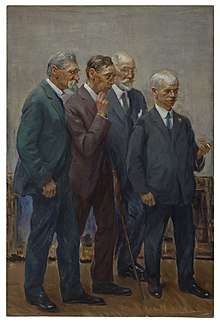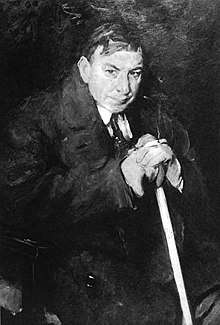Wayman Elbridge Adams
Wayman Elbridge Adams (September 23, 1883 – April 7, 1959)[1] was an American painter best known for his portraits of famous people. His skill at painting at high speed earned him the nickname 'Lightning'.


Life
He was born in Muncie, Indiana, and his early interest in drawing and painting was encouraged by his father, an amateur artist.[2] Adams later received formal instruction in the arts at the Herron School of Art of Indianapolis. Thereafter, he continued his studies under the guidance of painter William Merritt Chase in Italy (1910) and Robert Henri in Spain (1912).[2] In Italy, he met artist Margaret Graham Burroughs, and they married in 1918.[2]
On returning to the United States from his European studies, Adams opened a studio in Indianapolis, Indiana.[2] He subsequently lived and worked in New York and California.[2]
Art
Adams's mature style — featuring simplified composition, heavy brushstrokes, and patches of vivid color — shows the influence of both his teachers.[2] He became known as a specialist in portraits, and his subjects included four U.S. presidents — Calvin Coolidge, Warren Harding, William Henry Harrison, and Herbert Hoover — the artist Francis Focer Brown, and the writers Booth Tarkington and James Whitcomb Riley. His first important recognition as an artist came in 1918 when he won a Logan prize for his portrait of printmaker Joseph Pennell.[2]
Adams also turned out regional figure studies and street scenes in various media including painting, drawing, and printmaking.[2] One series focuses on the residents of San Francisco's Chinatown, and another on the residents of New Orleans, Louisiana, where he traveled frequently beginning in 1916.[2] A number of the New Orleans works foreground African-American subjects.[2] There are also portraits of notable New Orleans residents, including author Grace King, artist Ellsworth Woodward, and mayor Martin Behrman.[2]
Adams was well known in American artistic circles for his speedy painting technique, which earned him the nickname of 'Lightning.[2] His portraits were often completed in one sitting.[2]
He exhibited widely in the United States and had an exhibition at the Musée du Luxembourg in Paris in 1919.[2] In 1921, he was elected an associate of the National Academy of Design.[2]
Adams and his wife ran a summer art school in Elizabethtown, New York, from 1933 to 1945.[2] Among Adams's pupils were Sister Mary Rufinia and Lucy Wilson Rice.[3]
He died in Austin, Texas. His work is in the collection of the New Orleans Museum of Art and other institutions.[2] His work was also part of the painting event in the art competition at the 1932 Summer Olympics.[4]
Awards
- National Academy of Design — Proctor prize for portraiture (1914)
- Mr and Mrs Frank G. Logan Prize (1918)
- International Expo, Venice, Italy (1924)
- Greenough Memorial Prize (1925)
- Sesquicentennial Exposition Medal (1926)
- National Academy of Design - first Altman Prize (1926)
- Carnegie Institute Prize (1943)
References
- Opitz, Editor, Glenn B. (1987). Mantle Fielding's Dictionary of american Painters, Sculptors & Engravers. Poughkeepsie, NY: Apollo Book. pp. 1047. ISBN 0-938290-04-5.
- Bonner, Judith H., and Estill Curtis Pennington, eds. The New Encyclopedia of Southern Culture: Volume 21: Art and Architecture. University of North Carolina Press, 2013, pp. 203-04.
- Judith Vale Newton and Carol Ann Weiss (2004). Skirting the Issue: Stories of Indiana's Historical Women Artists. Indiana Historical Society Press. ISBN 0-87195-177-0.
- "Wayman Elbridge Adams". Olympedia. Retrieved 4 August 2020.
Sources
- American Art Review - August, 1997 Masterworks of the Adirondacks - Welsch, Caroline M
- American Art Review - December, 2002 - the Herron School of Art Centennial - Warkel, Harriet G.
- Ask Art